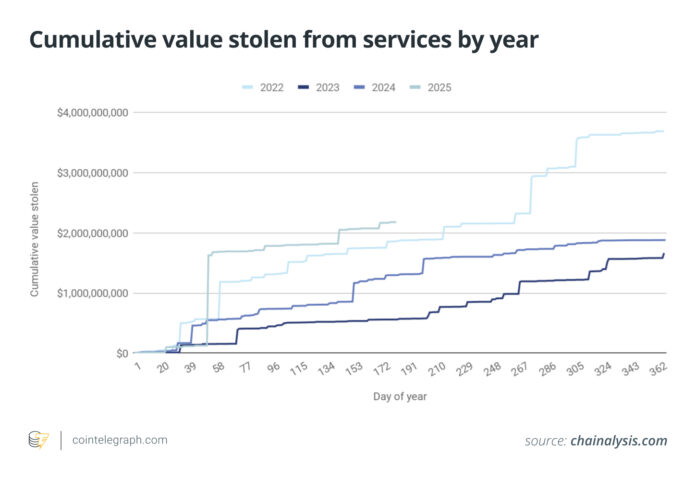Crypto Safety in 2025: Protecting Your Assets from Rising Threats
Crypto hacks continue to escalate, with over $2.4 billion stolen in the first half of 2025, surpassing the total losses of 2024. This alarming trend highlights the importance of robust security measures to safeguard crypto assets. A significant breach, such as the Bybit theft attributed to North Korean groups, contributes to the rising numbers but shouldn’t overshadow the everyday threats that lead to substantial losses.
Most losses still stem from simple yet effective traps, including phishing links, malicious wallet approvals, SIM swapping, and fake “support” accounts. However, implementing basic security habits can significantly reduce the risk of falling prey to these threats. Here are seven key habits to focus on in 2025.
1. Enhance Your 2FA: Phishing-Resistant Authentication
Relying on SMS codes for two-factor authentication (2FA) is no longer sufficient, as SIM swap attacks remain a common method for exploiting wallets. Transitioning to phishing-resistant 2FA methods, such as hardware security keys or platform passkeys, is a safer approach. Start by securing your most critical logins, including email, exchanges, and your password manager. Combine this with long, unique passphrases, store backup codes offline, and enable payout lists to restrict fund transfers to authorized addresses.
Did you know? Phishing attacks on crypto users increased by 40% in the first half of 2025, with fake exchange sites being a primary vector.
2. Signing Hygiene: Avoiding Wallet Drainers
Losing money often results from a single bad signature. Wallet drainers trick users into granting unlimited permissions or approving fraudulent transactions. To defend against this, read each signature request carefully, especially those containing “setApprovalForAll,” “Permit/Permit2,” or unlimited “approve” permissions. When experimenting with new decentralized applications (DApps), use a burner wallet and keep your most valuable assets in a separate, secure vault. Regularly revoke unused permits using tools like Revoke.cash to minimize risks.
3. Hot and Cold Wallets: Segregating Spending from Savings
Approach wallet management similar to how you manage bank accounts. A hot wallet is akin to a checking account, suitable for spending and interacting with apps, while a hardware or multisig wallet serves as a vault for long-term, secure storage. Keeping private keys offline significantly reduces exposure to malware and malicious websites. For long-term savings, write your seed phrase on paper or steel, and never save it on a phone, computer, or cloud service.
Did you know? In 2024, private key compromises accounted for 43.8% of all stolen crypto assets.
4. Device and Browser Hygiene
Setting up your device and browser is crucial for security. Enable automatic updates for your operating system, browser, and wallet apps, and restart them when necessary. Minimize browser extensions, as several high-profile thefts have been attributed to hijacked or malicious add-ons. Consider using a dedicated crypto-only browser or profile to prevent cross-contamination of browsing data.
5. Verifying Transactions: Addresses, Chains, and Contracts
The simplest way to lose crypto is by sending it to the wrong address. Always double-check the recipient address and network before initiating a transfer. For initial transfers, make a small test payment to verify the recipient’s address. When dealing with tokens or non-fungible tokens (NFTs), ensure you have the correct contract by checking the project’s official website and reputable aggregators like CoinGecko.
6. Defending Against Social Engineering
The largest crypto scams often rely on social engineering rather than complex code. Be wary of romance scams, job scams, and impersonation attempts. Real support staff will never ask for your private keys, redirect you to a similar website, or request payment via unconventional methods. If you notice these warning signs, cease contact immediately.
Did you know? The number of deposits in pig slaughter fraud cases increased by about 210% year-over-year in 2024, although the average amount per deposit fell.
7. Recovery Readiness: Turning Mistakes into Manageable Setbacks
Even with precautions, mistakes can happen. Having a recovery plan in place can turn a potential disaster into a survivable setback. Maintain an offline map of your key recovery resources, including verified exchange support links, a trusted revocation tool, and official reporting portals like the Federal Trade Commission and the FBI’s Internet Crime Complaint Center (IC3).
What to Do If the Worst Happens
If you’ve fallen victim to a scam or mistakenly sent funds to the wrong address, act swiftly. Transfer any remaining assets to a new, fully controlled wallet, then revoke old permissions using trusted tools. Change your passwords, switch to phishing-resistant 2FA, and log out of all other sessions. Contact your exchange to flag the destination addresses and file a report with IC3 or your local regulator, including transaction hashes, wallet addresses, timestamps, and screenshots to aid investigators.
The core lesson is that by adopting these seven habits—strong MFA, careful signing, segregation of hot and cold wallets, maintaining clean devices, verifying transactions, vigilance against social engineering, and having a recovery plan—you can block most everyday crypto threats. Start with small steps, such as enhancing your 2FA and tightening your signing hygiene, and build from there. A little preparation can save you from catastrophic losses in 2025.
This article does not contain any investment advice or recommendations. Every investment and trading activity involves risks, and readers should conduct their own research when making their decision.
For more information on crypto safety and the latest trends in cryptocurrency security, visit https://cointelegraph.com/news/crypto-safety-2025?utm_source=rss_feed&utm_medium=rss_category_analysis&utm_campaign=rss_partner_inbound

